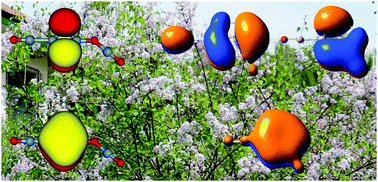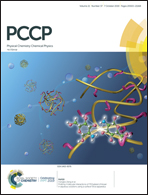Boron-based inorganic heterocyclic clusters: electronic structure, chemical bonding, aromaticity, and analogy to hydrocarbons
Abstract
This Perspective article deals with recent computational and experimental findings in boron-based heterocyclic clusters, which focuses on binary B–O and B–S clusters, as well as relevant ternary B–X–H (X = O, S, N) species. Boron is electron-deficient and boron clusters do not form monocyclic rings or linear chains. Boron-based heterocyclic clusters are intuitively even more electron-deficient and feature exotic chemical bonding, which make use of O 2p, S 3p, or N 2p lone-pairs for π delocalization over heterocyclic rings, facilitating new cluster structures and new types of bonding. Rhombic, pentagonal, hexagonal, and polycyclic clusters are discussed herein. Rhombic species are stabilized by four-center four-electron (4c-4e) π bonding, that is, the o-bond. An o-bond cluster differs from a typical 4π antiaromatic system, because it has 4π electrons in an unusual bonding/nonbonding combination, which takes advantage of the empty 2pz atomic orbitals from electron-deficient boron centers. A variety of examples (notably including boronyl boroxine) possess a hexagonal ring, as well as magic 6π electron-counting, making them new members of the inorganic benzene family. Pentagonal clusters bridge rhombic o-bond systems and inorganic benzenes, but they do not necessarily favor 6π electron-counting as in cyclopentadienide anion. In contrast, pentagonal 4π clusters are stable, leading to the concept of pentagonal o-bond. One electron can overturn the potential energy landscape of a system, enabling rhombic-to-hexagonal structural transition, which further reinforces the idea that 4π electron-counting is favorable for rhombic systems and 6π is magic for hexagonal rings. The bonding analogy between heterocyclic clusters and hydrocarbons goes beyond monocyclic species, which allows rational design of boron-based inorganic analogs of polycyclic aromatic hydrocarbons, including s-indacene as a puzzling aromatic/antiaromatic system. Selected linear B–O clusters are also briefly discussed, featuring dual 3c-4e π bonds, that is, ω-hyperbonds. Dual ω-hyperbonds, rhombic or pentagonal o-bond, and inorganic benzenes share a common chemical origin. The field of boron-based heterocyclic clusters is still in its infant stage, and much new chemistry remains to be discovered in forthcoming experimental and theoretical studies.



 Please wait while we load your content...
Please wait while we load your content...